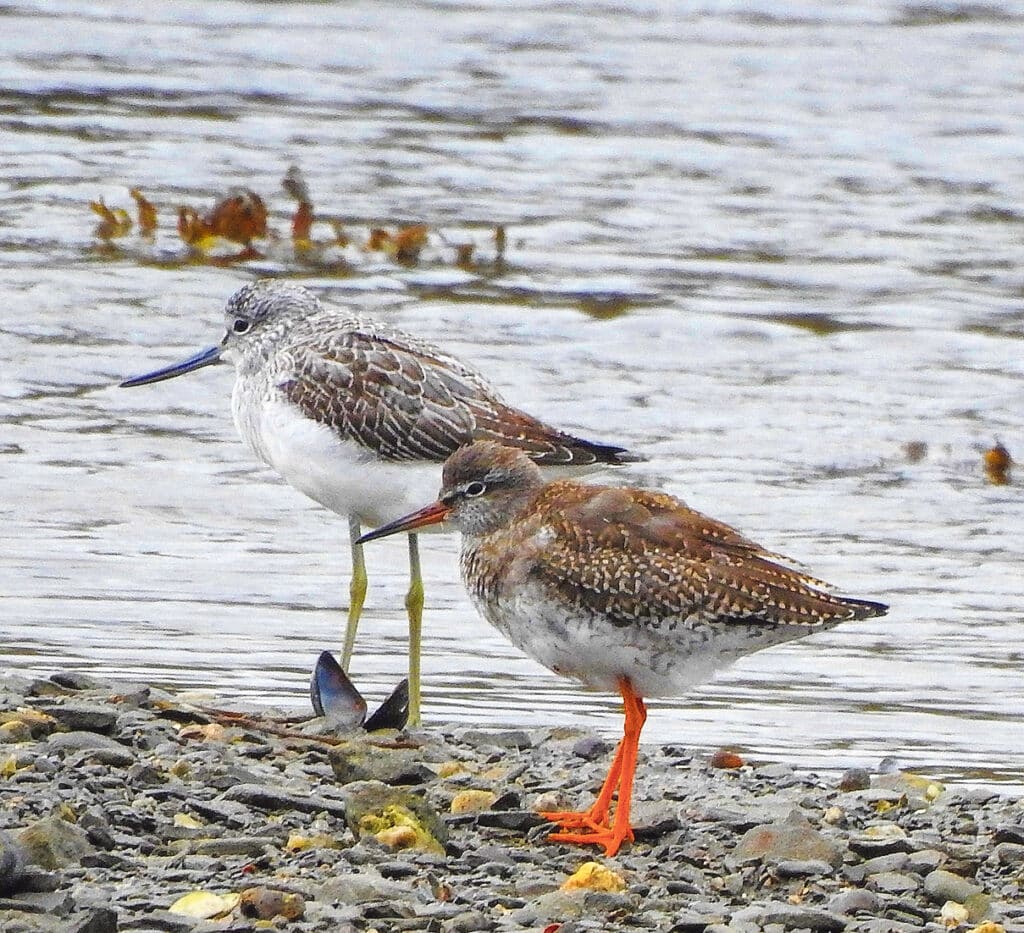This month Birdwatch West Cork committee member Damaris Lysaght shares one of her favourite birds, the Greenshank.

The Greenshank (Tringa nebularia) is on my short list of favourite birds. How could anyone not be impressed by this sleek, elegant and clean-cut bird, with its dark grey wings and back, and strongly contrasting bright white underparts. Its common English name is descriptive, as it has green shanks (legs). Similarly in Irish, ‘Laidhrín Glas’ means green legs. It is a mid to large-sized wader (wingspan 55-62 cm, length 30-34cm) with impressive long greenish grey legs and a long olive coloured slightly upturned bill, darker towards the tip. In flight there is no wing bar, but it shows a long wedge-shaped white rump extending up its back. Males and females look alike though the females are larger in size.
The Greenshank is a migratory bird and flies south in the autumn to spend the winter in southern Europe and west Africa as conditions in its breeding grounds in Russia, Siberia, Scandinavia and Scotland become too harsh and food is scarce. A proportion of them stop to rest and refuel in Ireland, numbers peaking in late summer and autumn, before travelling south again. These birds use the migration route known as the East Atlantic Flyway. But some remain here to spend the winter months.
There are only a couple of historic records of Greenshank nesting in Ireland. Our over-wintering Greenshank have most likely bred (hatched in the case of the juveniles) in rock-strewn boggy areas in the highlands and islands of Scotland. Three or four eggs are laid in a rough scrape, often beside a boulder or tree stump which is used as a singing post and vantage point. The eggs are brooded mostly by the female for about three-and-a-half weeks and shortly after hatching she departs, leaving the rearing of the chicks to the male. The chicks are precocial, meaning that they are relatively mature when they hatch, being covered in downy feathers and quite mobile, as opposed to naked and helpless like songbird chicks.
The winter habitats of the Greenshank are estuaries, coastal marshland and rocky shores and sometimes they can be found on the margins of freshwater lakes and wetlands. They are not very common, occurring singly or in small groups. They are predominantly visual feeders that hunt in channels and pools looking for invertebrates such as shrimps, crabs and small fish, probing the mud and vegetation with their bills or feet before grabbing their prey. They do not have webbed feet. Instead, their long thin legs and widely splayed long agile toes enable them to wade through their watery habitats easily without raising the sediment. Because they ingest so much salt in their diet, they have salt glands in their heads, which enable them to excrete excess salt through their nostrils. They choose safe high-tide roosts and spend a lot of time preening to keep their feathers waterproof. Their feather moult is gradual so there is never a time when they cannot fly. Having to be constantly wary of predators, different parts of their brains are adapted to sleep at different times so one eye will probably always be open! They can often be seen standing on one leg with the other tucked under their body and their head tucked under their wing. This is to preserve warmth because their beaks and legs lose heat.
The call of the Greenshank is ‘tieu tieu tieu’ and it is usually heard as an alarm call in flight. They know their call by instinct and therefore have no regional accents, unlike songbirds which learn their calls from their parents.
The Redshank (Tringa tetanus), a close relative of the Greenshank, is much more numerous on our estuaries. As its common name implies both in English and Irish (Cosdeargán), it has red legs. It is smaller than its relative, has brownish grey plumage with a partially red bill. A much rarer visitor to our shores is the Spotted Redshank. They are passage migrants moving between their breeding and wintering grounds in autumn and spring.
I-WeBS (Irish Wetland Bird Survey), Birdtrack and other surveys accumulate records of Greenshank and other waterbirds from which trends can be deduced. It seems that the Greenshank is doing relatively well compared to other waders. It is thought there are about 1,700 greenshanks distributed around the estuaries and wetlands of Ireland and the sites on the southwest Cork coast are particularly important.
BirdWatch Ireland West Cork Branch News
Upcoming events being held by the Branch are:
Sunday, February 11 Bantry – Gulls & Divers
Sunday, March 3 Timoleague and Courtmacsherry
Visit our website www.birdwatchirelandwestcork.ie for more information about these events. To receive news and reminders about our events join our mailing list by sending an email to mailinglist@birdwatchirelandwestcork.ie. For more information about the Branch, contact Fiona O’Neill at secretary@birdwatchirelandwestcork.ie.
Facebook
@BirdWatchIrelandWestCork
Twitter @BWIWestCork





